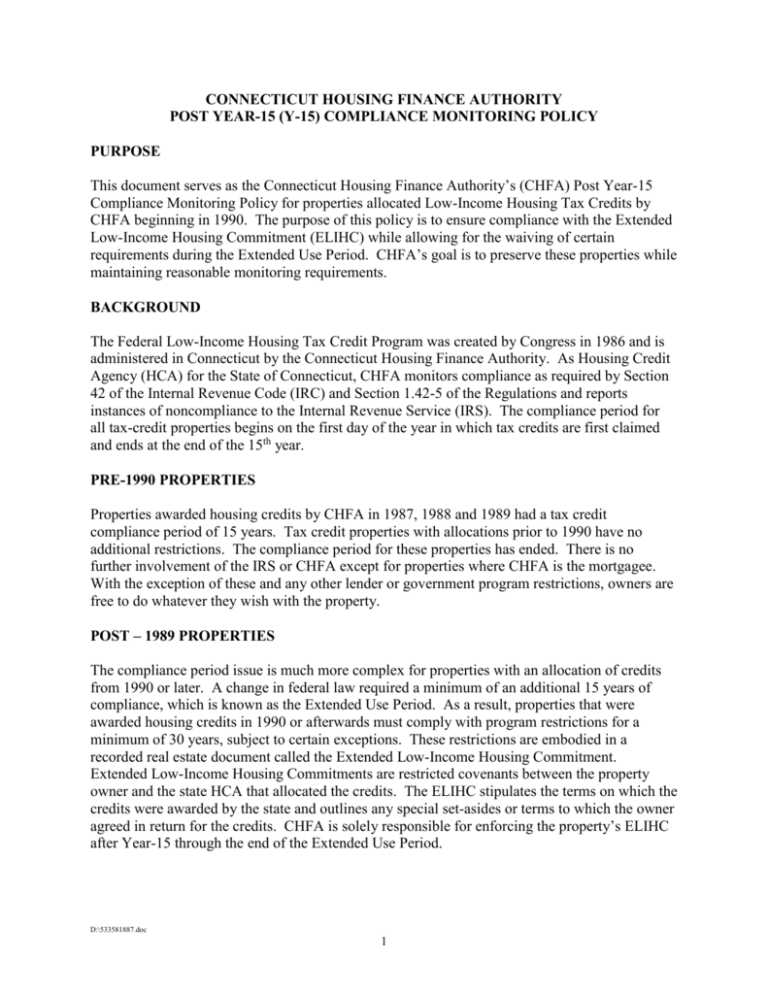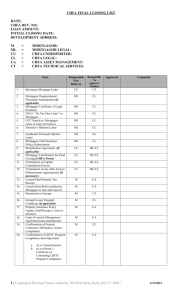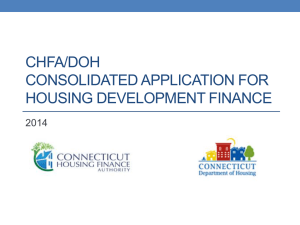WORD
advertisement

CONNECTICUT HOUSING FINANCE AUTHORITY POST YEAR-15 (Y-15) COMPLIANCE MONITORING POLICY PURPOSE This document serves as the Connecticut Housing Finance Authority’s (CHFA) Post Year-15 Compliance Monitoring Policy for properties allocated Low-Income Housing Tax Credits by CHFA beginning in 1990. The purpose of this policy is to ensure compliance with the Extended Low-Income Housing Commitment (ELIHC) while allowing for the waiving of certain requirements during the Extended Use Period. CHFA’s goal is to preserve these properties while maintaining reasonable monitoring requirements. BACKGROUND The Federal Low-Income Housing Tax Credit Program was created by Congress in 1986 and is administered in Connecticut by the Connecticut Housing Finance Authority. As Housing Credit Agency (HCA) for the State of Connecticut, CHFA monitors compliance as required by Section 42 of the Internal Revenue Code (IRC) and Section 1.42-5 of the Regulations and reports instances of noncompliance to the Internal Revenue Service (IRS). The compliance period for all tax-credit properties begins on the first day of the year in which tax credits are first claimed and ends at the end of the 15th year. PRE-1990 PROPERTIES Properties awarded housing credits by CHFA in 1987, 1988 and 1989 had a tax credit compliance period of 15 years. Tax credit properties with allocations prior to 1990 have no additional restrictions. The compliance period for these properties has ended. There is no further involvement of the IRS or CHFA except for properties where CHFA is the mortgagee. With the exception of these and any other lender or government program restrictions, owners are free to do whatever they wish with the property. POST – 1989 PROPERTIES The compliance period issue is much more complex for properties with an allocation of credits from 1990 or later. A change in federal law required a minimum of an additional 15 years of compliance, which is known as the Extended Use Period. As a result, properties that were awarded housing credits in 1990 or afterwards must comply with program restrictions for a minimum of 30 years, subject to certain exceptions. These restrictions are embodied in a recorded real estate document called the Extended Low-Income Housing Commitment. Extended Low-Income Housing Commitments are restricted covenants between the property owner and the state HCA that allocated the credits. The ELIHC stipulates the terms on which the credits were awarded by the state and outlines any special set-asides or terms to which the owner agreed in return for the credits. CHFA is solely responsible for enforcing the property’s ELIHC after Year-15 through the end of the Extended Use Period. D:\533581887.doc 1 Since the IRS is no longer involved in these properties after the initial 15-year compliance period, States must develop compliance monitoring procedures for the remaining years of the Extended Use Period. EXTENDED USE PERIOD CONTINUING PROVISIONS The following provisions contained in the Extended Low-Income Housing Commitment (executed before the end of the first year of the credit period) will remain in force for the entire Extended Use Period: 1. Failure to comply with the provisions of the ELIHC is an event of default, and the Authority or its successors may exercise any of the remedies available under the ELIHC. Furthermore, the Authority may seek specific performance of the ELIHC by the Owner or any successor in interest thereto, without declaring an event of default and without waiving any remedies in the ELIHC, by filing an action in any court of competent jurisdiction in the state of Connecticut. Note: Noncompliance may result in an owner being placed in the status of “not in good standing with CHFA.” The owner may not be eligible to apply for future Housing Credits in the State of Connecticut. 2. After the close of the compliance period, the Extended Use Period shall be for the same number of years as stipulated in the ELIHC. 3. The applicable fraction (as defined in §(c)(1) of Section 42 of the Code) for each taxable year in the Extended Use Period shall not be less than the applicable fraction stipulated in the ELIHC. The applicable fraction must be maintained during the ELIHC. 4. Individuals who meet the income limitation applicable under §(g)(1) of Section 42 of the Code (whether prospective, present, or former occupants who qualify, qualified, or would qualify) hereby have the right to enforce in any state court the requirements of the ELIHC and may apply to any state court for specific performance of the provisions of the ELIHC, not withstanding any action which may or may not be taken by the Authority. 5. The Extended Use Period shall continue after the close of the compliance period, unless terminated (Early Termination) on the date of foreclosure or deed in-lieu-of foreclosure or by Qualified Contract (if permitted by the ELIHC). 6. The development shall be occupied or be available for occupancy by Qualified Persons as defined in the Applicable Fraction. 7. The rent for each Qualified Unit shall not exceed the Qualified Rent, which will be uniform for each particular housing unit size, regardless of the number of persons residing in the household and in accordance with Section 42(g) of the Code. D:\533581887.doc 2 8. For the 3-year period following an Early Termination of the Extended Use Period: (i) (ii) No resident who was occupying a Qualified Unit at the end of the Extended Use Period may be removed (whether by eviction, lease expiration or any reason other than good cause); and No rent may be increased for any Qualified Unit beyond the Qualified Rent as long as it is occupied by the resident who was occupying the unit at the early termination of the Extended Use Period. 9. The ELIHC prohibits the disposition to any person of any portion of the building to which the ELIHC applies unless all of the building to which such ELIHC applies is disposed of to such persons. 10. The ELIHC must be recorded promptly on the land records of the town or city where the property is located prior to the recording of any other lien or restriction. 11. The Owner may not refuse to lease to a holder of a voucher or certificate of eligibility under Section 8 of the U.S. Housing Act of 1937 because of the status of the prospective tenant as such a holder. 12. The restrictive covenants of the ELIHC shall be binding on all successors and assigns of the Owner and this commitment shall be recorded pursuant to Connecticut law and a restrictive covenant. 13. The ELIHC shall be governed by and construed in accordance with the laws of the State of Connecticut and federal law, where applicable. 14. The invalidity of any provisions of the ELIHC shall not be deemed to impair or affect in any manner the validity, enforceability, or effect of the remainder of the provisions of the ELIHC, which shall continue in full force and effect as if such invalid provision had never been included herein. 15. The owner must comply with all requirements of the Fair Housing Act. CHFA’S COMPLIANCE MONITORING REQUIREMENTS AFTER END OF INITIAL 15-YEAR COMPLIANCE PERIOD There is no IRS compliance monitoring requirement during the Extended Use Period and Housing Credit Agencies no longer report to the IRS. Therefore, CHFA established a policy regarding how properties will be monitored and consequences for noncompliance during the Extended Use Period. Based on the requirements of the Extended Low-Income Housing Commitment specified in Section 42 of the Code, CHFA has the authority to establish different compliance criteria during the Extended Use Period. D:\533581887.doc 3 The Post Year-15 compliance requirements will be in place and monitored during the Extended Use Period. CHFA believes these changes, which eliminate and/or streamline current IRS requirements, will prove to be beneficial to owners and managers of Housing Credit properties. The following is a comparison of CHFA Pre and Post Year-15 compliance monitoring requirements: 1. INCOME AND RENT RESTRICTIONS Initial 15-year Compliance Period: IRS Code requires that Qualified Units be income and rent restricted. Extended Use Compliance Period: No change. Qualified Persons must be income qualified in accordance with current Housing Credit Income Limits. Qualified Households may not pay more than the Qualified Rent. 2. INITIAL ELIGIBILITY AND CERTIFICATION Initial 15-Year Compliance Period: IRS Code requires that the owner determine an applicant’s eligibility for a Housing Credit Unit prior to initial occupancy. Income and assets must be verified by thirdparty verification in accordance with HUD Handbook 4350.3. Extended Use Compliance Period: No change in verification process. The Tenant Income Certification Form (TIC) must be completed. Initial eligibility must be confirmed in accordance with HUD guidelines as stated in HUD Handbook 4350.3. D:\533581887.doc 4 3. ANNUAL RECERTIFICATION OF HOUSEHOLDS Initial 15-Year Compliance Period: Until July 30, 2008 and the adoption of HR 3221, the Housing and Economic Recovery Act of 2008, Section 1.42-5 of the Regulations required that a recertification of household income, including third-party verification, be completed at least once every 12 months after initial occupancy. HR 3221 waived this requirement for 100% Housing Credit and Bond Properties. Recertification is still required for all other properties, including Assisted Living. Extended Use Compliance Period: Change. CHFA will require that an initial Tenant Certification and an anniversary recertification be completed. Thereafter, the owner may self-certify tenants for all properties except Assisted Living. However, CHFA will require that the owner provide certain information annually to include tenant data, changes in household composition and student status. 4. BUILDING RULE Initial 15-Year Compliance Period: Change. IRS Code requires that compliance monitoring be conducted on a buildingby-building basis. Extended Use Compliance Period: Change. CHFA will conduct compliance monitoring on a project-wide basis. 5. MINIMUM SET-ASIDE Initial 15-Year Compliance Period: IRS Code requires that an owner satisfy minimum set-aside requirements of either 20/50 or 40/60 throughout the compliance period. Extended Use Compliance Period: Change. Minimum set-aside requirements (MSA) must continue to be met. However, MSA may now be satisfied on a project basis instead of each individual building. D:\533581887.doc 5 6. APPLICABLE FRACTION Initial 15-Year Compliance Period: IRS Code states that the applicable fraction for determining qualified basis is the lesser of the number of low-income units as a percentage of all residential units; or the total floor space of low-income units as a percentage of the total floor space of all residential units. Extended Use Compliance Period: Change. The applicable fraction will be determined by the unit fraction. 7. STUDENT RULE Initial 15-Year Compliance Period: IRS Code states that households consisting entirely of full-time students are not eligible to occupy housing credit units unless certain exceptions are met. Extended Use Compliance Period: Change. Housing credit units may now be occupied by households consisting entirely of income-eligible, full-time students with one exception. Full-time students must verify that they are not dependents on their parents’ tax return (proof required) so that these units are not substitutes for dormitories. 8. UNIT TRANSFERS Initial 15-Year Compliance Period: IRS Code allows for unit transfers within a building and between buildings in the same project without recertification of eligibility. Extended Use Compliance Period: Unit transfers in a building and between buildings in the same property will be permitted without recertification of eligibility. D:\533581887.doc 6 9. NEXT AVAILABLE UNIT / 140% RULE Initial 15-Year Compliance Period: Change. IRS Code states that if the household income for residents in a qualified unit increases to more than 140% of the current applicable income limit, the unit is considered an “over-income unit” but may continue to be counted as a low-income unit as long as two conditions are met. The unit must continue to be rent restricted and the next comparable size unit in the building must be rented to a qualified lowincome tenant. The owner of a low-income building must rent to qualified residents all comparable units that are available or that subsequently become available in the same building until the applicable fraction (excluding the over-income units) is restored to the percentage on which the credit is based. Extended Use Compliance Period: CHFA has eliminated the Next Available Unit Rule. 10. VACANT UNIT RULE Initial 15-Year Compliance Period: IRS Code states that if a qualified unit becomes vacant and the owner makes reasonable attempts to re-rent the unit, the vacant unit continues to generate credits. Vacant units must be rent-ready. Extended Use Compliance Period: No change. The owner must make reasonable attempts to rent all vacant units. 11. DEEP INCOME TARGETING Initial 15-Year Compliance Period: Properties are bound by CHFA to the deep-targeting commitments made by the owner as a condition of the allocation process. Extended Use Compliance Period: No change. Owners were awarded points in the competitive allocation process for deep targeting of income. Points for deep targeting had a significant impact on those properties awarded credits. Therefore, this requirement remains in place. D:\533581887.doc 7 12. UTILITY ALLOWANCES Initial 15-Year Compliance Period: The IRS requires utility allowances to be updated annually. Extended Use Compliance Period: No change. Utility Allowances must be updated annually as determined by IRS regulations. 13. ANNUAL STATUS REPORT Initial 15-Year Compliance Period: Owners currently provide a unit status report to CHFA’s Authorized Delegate by April 1. Extended Use Compliance Period: No change. A status report is still required to be e-mailed to CHFA’s Authorized Delegate by April 1. NOTE: Owners are required to submit to CHFA’s Authorized Delegate a status report by April 1 following the end of the fifteenth year of the compliance period. Failure to do so will result in the transmittal of Form 8823 to the IRS. 14. OWNER’S CERTIFICATE OF CONTINUING LIHTC PROGRAM COMPLIANCE Initial 15-Year Compliance Period IRS Code requires the annual submission of the Owner’s Certificate of Continuing LIHTC Program Compliance. Extended Use Compliance Period Change. CHFA will require the annual submission of a modified Owner’s Certificate of Continuing LIHTC Program Compliance on April 1 of each year of the ELIHC period. D:\533581887.doc 8 15. UNIT AND FILE INSPECTIONS Initial 15-Year Compliance Period: IRS Code requires inspections of all buildings and at least 20% of buildings, units and files once every three years. Extended Use Compliance Period: Change. CHFA will require inspections of all buildings and 20% of the project’s units and files once every five years. CHFA reserves the right to inspect more frequently if necessary. 16. IRS FORM 8823 Initial 15-Year Compliance Period: Change. IRS Code requires the Housing Credit Agency to report findings of noncompliance using IRS Form 8823. Extended Use Compliance Period: Change. CHFA will continue to use IRS Form 8823 to report findings of noncompliance to the Owner. However, CHFA will not submit this form to the IRS. 17. TRANSFER OF OWNERSHIP/MANAGEMENT Initial 15-Year Compliance Period: Owners must advise CHFA of any change in ownership or management. CHFA approval of transfers of ownership and change in management is required. Extended Use Compliance Period: No change. CHFA must be advised of and approve all changes. 18. MONITORING FEES Initial 15-Year Compliance Period: Monitoring fees were collected up front as a percentage of the first year’s credit allocation. Extended Use Compliance Period: D:\533581887.doc 9 The Authority may collect from the Owner reasonable monitoring fees in an amount to be determined to cover expenses. Such fees will be applicable to all properties awarded tax credits after January 1, 2011. Fees are due annually on April 1 along with the Owner’s Annual Certification and Status Report. CHFA reserves the right to adjust fees due to changing circumstances, rules or regulations. DISCLAIMER: The above Policy applies to Nine Percent (9%) Housing Credit Properties and Four Percent (4%) Credit Properties with Tax Exempt Bonds. Properties with RD, HUD Subsidy, and HOME Funds, etc must continue to meet the requirements of each respective Program. Prior to implementing any changes in management practices, owners should seek counsel from their tax professionals and have discussion with other lenders, investors and syndicators. Compliance with requirements of the ELIHC is the responsibility of the owner of the building for which the credit is allowed. CHFA’s obligation to monitor for compliance with the requirements of the ELIHC does not make CHFA liable for an owner’s noncompliance. D:\533581887.doc 10




